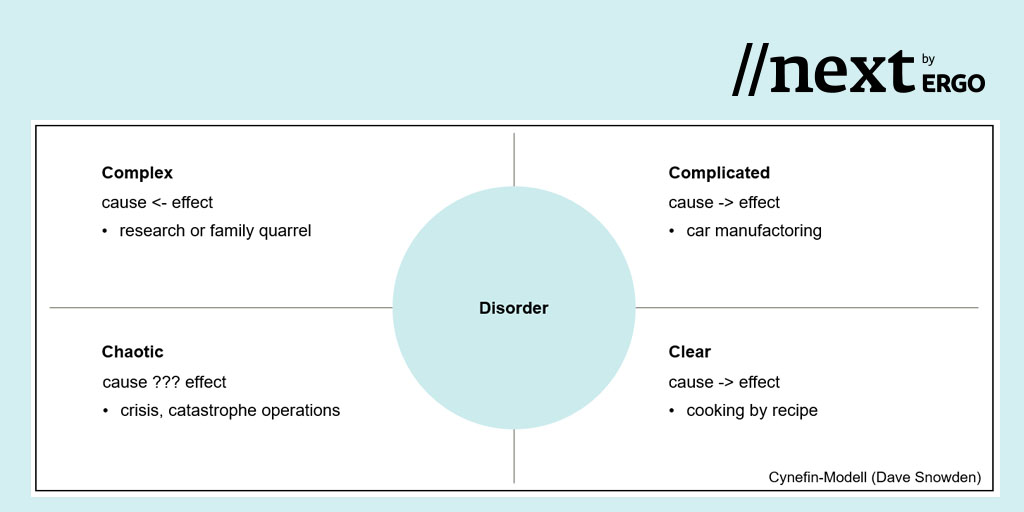Cynefin? Bless you. No, cynefin is not a new virus. It is a model for knowledge management that was developed 20 years ago by the Welsh scholar Dave Snowden. He explored the question of what different approaches there are to overcome challenges. Hannes Kropf, Agile Coach and Project Manager at ITERGO, describes how the model has helped him to deal calmly with the corona situation.
By Hannes Kropf, Agile Coach und Projekt Manager at ITERGO
I am convinced: The Cynefin model can help us to deal better with the next crisis. With it, we can do something for our resilience and look optimistically into the future despite all imponderables.
Cynefin is a Welsh word meaning environment or habitat. It is pronounced [Kü-nä-wi-en] or [Kü-nä-win]: https://de.forvo.com/word/cynefin/
Before I explain the connection to the Corona pandemic's challenges, I will briefly describe the model with its five areas.
In the clear area, there is a relationship between cause and effect that is comprehensible to every person. Every person can understand this relationship. It points temporally into the future. An example of planning and acting in the clear realm is cooking by recipe. Everything I can check off with a simple to-do list falls into this area.
To solve challenges in this area, I need to check, categorise, respond. I can apply best practices (usually, there is only one).
In the complicated area, the same relationship exists between cause and effect. It is apparent and explainable to experts.
If I want to understand why my digital radio gets louder when I turn the volume control, I must ask a physicist. He explains to me how the transistor circuit in the radio amplifies the current in the loudspeaker.
Classical project management is oriented towards acting in a complicated area. The experts impart their knowledge to the project manager. Together they develop a proper project plan. Here, one approaches by checking, analysing, responding, and applying good practices (there are often several).
The relationship between cause and effect is temporally directed into the past in the complex field. I can only understand my challenge in retrospect.
Like a family quarrel, I know there will be an argument at Christmas. But I don't know in advance who is involved and what the issue is. Afterward I am smarter: Uncle Erwin and Aunt Martha argued about the family finances this year.
Researchers try things out and experiment to explain why a thing behaves the way it does. They try to experiment in a safe context. In the chemistry lab, one first works with small amounts of substances. Once the context is understood, larger quantities are taken.
Here the approach is to try, test, respond, and one can then identify practices in the making (emergent practice).
In the chaotic area, no one knows the relationship between cause and effect. In addition, there is a high time pressure to act.
A house fire is a new situation for the fire brigade every time. Nevertheless, it has prepared itself through regular training and practice to deal with this unknown situation. In addition, they must act as quickly as possible.
Here the approach is Act, Check, Respond, and one can discover new practices.
If you cannot assign the challenge to one of the four areas, you end up in disorder.
Here you react with what you do best: Many go into the clear or the complicated area. People with an agile mindset find the problem in the complex context and employees from disaster staffs in the chaotic one. Often, they all end up in the wrong area.
From my experience, I first look at the pressure to act from disorderly situations before deciding on the chaotic or complex area depending on this. Then I check whether experts can help me solve the problem. If there are no experts, I stay in the complex area. But if there are, I should switch to a more manageable situation in the complex area. A simple task list will not help.

So if we now try to assign the various challenges in the context of the Corona pandemic to the different cynefin areas, some of the decisions made by politicians, researchers and parts of the population are somewhat easier to understand.
What else can the model show us? In all areas, there are learning loops that regularly review how a challenge can be solved better. It must be about how to strengthen procedures and decisions that went well and how to improve things that did not go optimally. This is where we are all invited to engage in this learning.
For those who want to think through the Cynefin model in more detail, I recommend the book "Cynefin - weave sense-making into the fabric of our world" by Dave Snowden & Friends.
Most popular